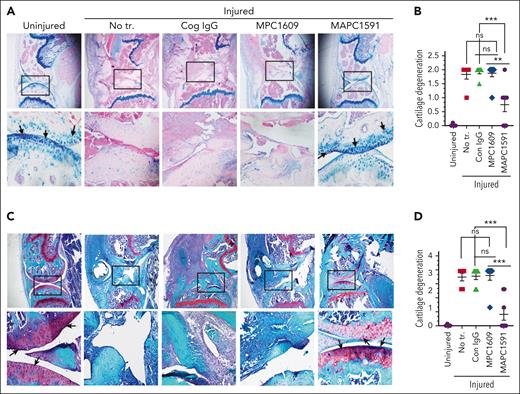Page 2836: Because of an error during the publication process, in the upper row of Figure 5C, the second image was inadvertently duplicated from the third image in the row. The error does not alter the conclusions of the study or the interpretation of the data in the figure. In addition, in the figure legend, “Loss of blue stain (A) or red stain (B)” should read “Loss of blue stain (A) or red stain (C).” The corrected Figure 5 and legend are shown below.
Treatment of FVIII−/− mice with an mAb that selectively inhibits APC anticoagulant activity (MAPC1591) reduces cartilage degeneration following a joint bleed. FVIII−/− mice were administered with control IgG, MPC1609, or MAPC1591 (1 mg/kg, ip). Twenty-four hours later, joint bleeding was induced with a needle puncture. Two weeks after the injury, mice were euthanized; knee joints were excised, and joint tissue sections were stained with Alcian blue (A) or Safranin O/Fast Green (C). Top panel images were captured at ×4 magnification. The squared area was imaged at ×20 magnification (bottom panel). Arrows point out the articular cartilage. Loss of blue stain (A) or red stain (C) in the articular cartilage region indicates the loss of glycosaminoglycans in the region and cartilage degeneration. (B) Cartilage degeneration in tissue sections stained with Alcian blue was scored on a 0 to 2 scale (0, absence of cartilage degeneration; 1, partial loss of proteoglycan content and pannus formation; 2, complete cartilage degeneration/absence of proteoglycans, pannus formation, and femur remodeling). (D) The quantified score of cartilage degeneration based on Safranin O/Fast Green Staining (0 to 3 scale; 0, normal/bright red staining of cartilage; 1, a slight reduction in staining; 2, a moderate reduction in staining; and 3, severe reduction/complete loss of staining). The data shown are mean ± SEM. ns, not statistically significant difference. ∗∗P < .01; ∗∗∗P < 0 .001.
Treatment of FVIII−/− mice with an mAb that selectively inhibits APC anticoagulant activity (MAPC1591) reduces cartilage degeneration following a joint bleed. FVIII−/− mice were administered with control IgG, MPC1609, or MAPC1591 (1 mg/kg, ip). Twenty-four hours later, joint bleeding was induced with a needle puncture. Two weeks after the injury, mice were euthanized; knee joints were excised, and joint tissue sections were stained with Alcian blue (A) or Safranin O/Fast Green (C). Top panel images were captured at ×4 magnification. The squared area was imaged at ×20 magnification (bottom panel). Arrows point out the articular cartilage. Loss of blue stain (A) or red stain (C) in the articular cartilage region indicates the loss of glycosaminoglycans in the region and cartilage degeneration. (B) Cartilage degeneration in tissue sections stained with Alcian blue was scored on a 0 to 2 scale (0, absence of cartilage degeneration; 1, partial loss of proteoglycan content and pannus formation; 2, complete cartilage degeneration/absence of proteoglycans, pannus formation, and femur remodeling). (D) The quantified score of cartilage degeneration based on Safranin O/Fast Green Staining (0 to 3 scale; 0, normal/bright red staining of cartilage; 1, a slight reduction in staining; 2, a moderate reduction in staining; and 3, severe reduction/complete loss of staining). The data shown are mean ± SEM. ns, not statistically significant difference. ∗∗P < .01; ∗∗∗P < 0 .001.


This feature is available to Subscribers Only
Sign In or Create an Account Close Modal